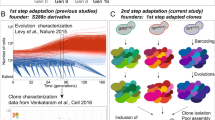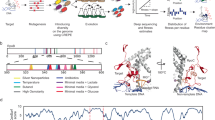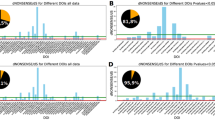Abstract
Understanding the mechanisms of evolution requires identification of the molecular basis of the multiple (pleiotropic) effects of specific adaptive mutations. We have characterized the pleiotropic effects on protein levels of an adaptive single–base pair substitution in the coding sequence of a signaling pathway gene in the bacterium Pseudomonas fluorescens SBW25. We find 52 proteomic changes, corresponding to 46 identified proteins. None of these proteins is required for the adaptive phenotype. Instead, many are found within specific metabolic pathways associated with fitness-reducing (that is, antagonistic) effects of the mutation. The affected proteins fall within a single coregulatory network. The mutation 'rewires' this network by drawing particular proteins into tighter coregulating relationships. Although these changes are specific to the mutation studied, the quantitatively altered proteins are also affected in a coordinated way in other examples of evolution to the same niche.
This is a preview of subscription content, access via your institution
Access options
Subscribe to this journal
Receive 12 print issues and online access
$209.00 per year
only $17.42 per issue
Buy this article
- Purchase on Springer Link
- Instant access to full article PDF
Prices may be subject to local taxes which are calculated during checkout




Similar content being viewed by others
References
Barton, N.H. & Turelli, M. Evolutionary quantitative genetics: how little do we know? Annu. Rev. Genet. 23, 337–370 (1989).
Lande, R. The genetic covariance between characters maintained by pleiotropic mutations. Genetics 94, 203–215 (1980).
Stearns, S.C. The Evolution of Life Histories (Oxford Univ. Press, Oxford, 1992).
Foster, K.R., Shaulsky, G., Strassmann, J.E., Queller, D.C. & Thompson, C.R. Pleiotropy as a mechanism to stabilize cooperation. Nature 431, 693–696 (2004).
Wright, S. Evolution and the Genetics of Populations; a Treatise (Univ. Chicago Press, Chicago, 1968).
Barton, N.H. Pleiotropic models of quantitative variation. Genetics 124, 773–782 (1990).
Promislow, D.E. Protein networks, pleiotropy and the evolution of senescence. Proc. R. Soc. Lond. B 271, 1225–1234 (2004).
Bochdanovits, Z. & de Jong, G. Antagonistic pleiotropy for life-history traits at the gene expression level. Proc. R. Soc. Lond. B 271 (Suppl.), S75–S78 (2004).
Caspari, A. Pleiotropic gene action. Evolution Int. J. Org. Evolution 6, 1–18 (1952).
Knight, C.G., Azevedo, R.B. & Leroi, A.M. Testing life-history pleiotropy in Caenorhabditis elegans. Evolution Int. J. Org. Evolution 55, 1795–1804 (2001).
Patel, M.N., Knight, C.G., Karageorgi, C. & Leroi, A.M. Evolution of germ-line signals that regulate growth and aging in nematodes. Proc. Natl. Acad. Sci. USA 99, 769–774 (2002).
Leroi, A.M. Molecular signals versus the Loi de Balancement. Trends Ecol. Evol. 16, 24–29 (2001).
Estes, S., Ajie, B.C., Lynch, M. & Phillips, P.C. Spontaneous mutational correlations for life-history, morphological and behavioral characters in Caenorhabditis elegans. Genetics 170, 645–653 (2005).
Leroi, A.M. et al. What evidence is there for the existence of individual genes with antagonistic pleiotropic effects? Mech. Ageing Dev. 126, 421–429 (2005).
Rainey, P.B., Buckling, A., Kassen, R. & Travisano, M. The emergence and maintenance of diversity: insights from experimental bacterial populations. Trends Ecol. Evol. 15, 243–247 (2000).
Rainey, P.B. & Travisano, M. Adaptive radiation in a heterogeneous environment. Nature 394, 69–72 (1998).
Rainey, P.B. & Rainey, K. Evolution of cooperation and conflict in experimental bacterial populations. Nature 425, 72–74 (2003).
MacLean, R.C., Bell, G. & Rainey, P.B. The evolution of a pleiotropic fitness tradeoff in Pseudomonas fluorescens. Proc. Natl. Acad. Sci. USA 101, 8072–8077 (2004).
Goymer, P. et al. Adaptive divergence in experimental populations of Pseudomonas fluorescens. II. The role of the GGDEF regulator WspR in evolution and development of the wrinkly spreader phenotype. Genetics 173, 515–526 (2006).
Spiers, A.J., Kahn, S.G., Bohannon, J., Travisano, M. & Rainey, P.B. Adaptive divergence in experimental populations of Pseudomonas fluorescens. I. Genetic and phenotypic bases of wrinkly spreader fitness. Genetics 161, 33–46 (2002).
Morales, G. et al. The Pseudomonas putida Crc global regulator controls the expression of genes from several chromosomal catabolic pathways for aromatic compounds. J. Bacteriol. 186, 1337–1344 (2004).
Wolff, J.A., MacGregor, C.H., Eisenberg, R.C. & Phibbs, P.V. Jr. Isolation and characterization of catabolite repression control mutants of Pseudomonas aeruginosa PAO. J. Bacteriol. 173, 4700–4706 (1991).
Hester, K.L., Madhusudhan, K.T. & Sokatch, J.R. Catabolite repression control by crc in 2xYT medium is mediated by posttranscriptional regulation of bkdR expression in Pseudomonas putida. J. Bacteriol. 182, 1150–1153 (2000).
Rietsch, A., Wolfgang, M.C. & Mekalanos, J.J. Effect of metabolic imbalance on expression of type III secretion genes in Pseudomonas aeruginosa. Infect. Immun. 72, 1383–1390 (2004).
Nishijyo, T., Haas, D. & Itoh, Y. The CbrA-CbrB two-component regulatory system controls the utilization of multiple carbon and nitrogen sources in Pseudomonas aeruginosa. Mol. Microbiol. 40, 917–931 (2001).
Weckwerth, W., Loureiro, M.E., Wenzel, K. & Fiehn, O. Differential metabolic networks unravel the effects of silent plant phenotypes. Proc. Natl. Acad. Sci. USA 101, 7809–7814 (2004).
Zahn, C.T. Graph-theoretical methods for detecting and describing gestalt clusters. IEEE Trans. Comput. C20, 68–86 (1971).
Marden, J.H., Rogina, B., Montooth, K.L. & Helfand, S.L. Conditional tradeoffs between aging and organismal performance of Indy long-lived mutant flies. Proc. Natl. Acad. Sci. USA 100, 3369–3373 (2003).
Jenkins, N.L., McColl, G. & Lithgow, G.J. Fitness cost of extended lifespan in Caenorhabditis elegans. Proc. R. Soc. Lond. B 271, 2523–2526 (2004).
de Bono, M. & Bargmann, C.I. Natural variation in a neuropeptide Y receptor homolog modifies social behavior and food response in C. elegans. Cell 94, 679–689 (1998).
Davies, A.G., Bettinger, J.C., Thiele, T.R., Judy, M.E. & McIntire, S.L. Natural variation in the npr-1 gene modifies ethanol responses of wild strains of C. elegans. Neuron 42, 731–743 (2004).
Lupas, A. & Stock, J. Phosphorylation of an N-terminal regulatory domain activates the CheB methylesterase in bacterial chemotaxis. J. Biol. Chem. 264, 17337–17342 (1989).
O'Toole, G.A., Gibbs, K.A., Hager, P.W., Phibbs, P.V., Jr. & Kolter, R. The global carbon metabolism regulator Crc is a component of a signal transduction pathway required for biofilm development by Pseudomonas aeruginosa. J. Bacteriol. 182, 425–431 (2000).
Stuart, J.M., Segal, E., Koller, D. & Kim, S.K. A gene-coexpression network for global discovery of conserved genetic modules. Science 302, 249–255 (2003).
Welch, J.J. & Waxman, D. Modularity and the cost of complexity. Evolution Int. J. Org. Evolution 57, 1723–1734 (2003).
Ehrich, T.H. et al. Pleiotropic effects on mandibular morphology I: developmental morphological integration and differential dominance. J. Exp. Zoolog. B Mol. Dev. Evol. 296, 58–79 (2003).
Rainey, P.B. & Cooper, T.F. Evolution of bacterial diversity and the origins of modularity. Res. Microbiol. 155, 370–375 (2004).
Beaumont, H.J.E. et al. The genetics of phenotypic innovation. in Prokaryotic Diversity: Mechanisms and Significance (Society for General Microbiology Symposium 66) (eds. Logan, N.A., Lappin-Scott, H.M. & Oyston, P.C.F.) 91–104 (Cambridge Univ. Press, Cambridge, 2006).
McAdams, H.H., Srinivasan, B. & Arkin, A.P. The evolution of genetic regulatory systems in bacteria. Nat. Rev. Genet. 5, 169–178 (2004).
Spiers, A.J., Bohannon, J., Gehrig, S.M. & Rainey, P.B. Biofilm formation at the air-liquid interface by the Pseudomonas fluorescens SBW25 wrinkly spreader requires an acetylated form of cellulose. Mol. Microbiol. 50, 15–27 (2003).
Spiers, A.J. & Rainey, P.B. The Pseudomonas fluorescens SBW25 wrinkly spreader biofilm requires attachment factor, cellulose fibre and LPS interactions to maintain strength and integrity. Microbiol. 151, 2829–2839 (2005).
O'Neill, E.E. et al. Towards complete analysis of the platelet proteome. Proteomics 2, 288–305 (2002).
Garcia, A. et al. Differential proteome analysis of TRAP-activated platelets: involvement of DOK-2 and phosphorylation of RGS proteins. Blood 103, 2088–2095 (2004).
Karp, N.A. & Lilley, K.S. Maximising sensitivity for detecting changes in protein expression: experimental design using minimal CyDyes. Proteomics 5, 3105–3115 (2005).
Benjamini, Y. & Hochberg, Y. Controlling the false discovery rate: a practical and powerful approach to multiple testing. J. R. Stat. Soc. Ser. B Methodol. 57, 289 (1995).
Sall, J., Creighton, L. & Lehman, A. JMP Start Statistics (Brooks/Cole–Thomson Learning, Belmont, California, 2005).
Pinheiro, J.C. & Bates, D.M. Mixed-Effects Models in S and S-PLUS (Springer, New York, 2000).
R development core team. R: A language and environment for statistical computing. (R Foundation for Statistical Computing, Vienna, 2005).
Batageli, V. & Mrvar, A. Pajek – Analysis and visualization of large networks. in Graph Drawing Software (eds. Jünger, M. & Mutzel, P.) 77–103 (Springer, Berlin, 2003).
Acknowledgements
We thank M. Fricker, O. Suleman and D. Bebber for ideas and assistance with network analyses; C. Maclean for discussions of the WS system; A. Spiers for assistance with P. fluorescens; S. Knight for assistance with the manuscript and the Natural Environment Research Council's Environmental Genomics program for funding.
Author information
Authors and Affiliations
Corresponding author
Ethics declarations
Competing interests
The authors declare no competing financial interests.
Supplementary information
Supplementary Fig. 1
Proteomic and Biolog data in relation to degradation pathways into the TCA cycle. (PDF 305 kb)
Supplementary Fig. 2
Protein levels across strains. (PDF 345 kb)
Supplementary Table 1
Proteins corresponding to spots found to differ significantly in expression between ancestral (SM) and evolved (LSWS) genotypes. (PDF 366 kb)
Rights and permissions
About this article
Cite this article
Knight, C., Zitzmann, N., Prabhakar, S. et al. Unraveling adaptive evolution: how a single point mutation affects the protein coregulation network. Nat Genet 38, 1015–1022 (2006). https://doi.org/10.1038/ng1867
Received:
Accepted:
Published:
Issue Date:
DOI: https://doi.org/10.1038/ng1867
This article is cited by
-
The Mystery of Cancer Resistance: A Revelation Within Nature
Journal of Molecular Evolution (2023)
-
Elusive vehicles of genetic representation
Biology & Philosophy (2020)
-
Antagonistic Pleiotropy in Human Disease
Journal of Molecular Evolution (2020)
-
New insights into bacterial adaptation through in vivo and in silico experimental evolution
Nature Reviews Microbiology (2012)
-
Laboratory evolution of Geobacter sulfurreducens for enhanced growth on lactate via a single-base-pair substitution in a transcriptional regulator
The ISME Journal (2012)



